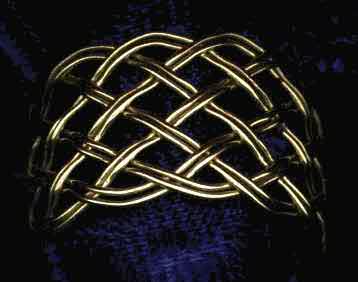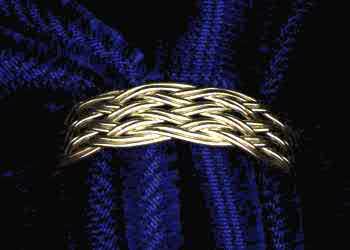Ring sizing -- and finger measuring.
|
There are more than one "standard" for measurement of ring size. The US has an arbitrary numbering system that appears unrelated to any physical dimension of the finger or ring, but it has the virtue of being very widely accepted here. I've provided a chart which compares the various methods. Some scales are literal measurements of the ring, i.e., the circumference of the inside, in millimeters or inches, the French and German standards, respectively.
Taking a strip of paper about 1/4" (6mm) wide and wrapping it around your finger where your ring would go, and measuring how long one complete turn is, will give a good approximation of your ring size. I recommend cutting through the paper band, rather than marking it with a pen or pencil. You can either measure it carefully, or put the strip into an envelope and send it to me. I've got some illustrations of this method that may make this clearer.
|
Weave -- Loose, or Tight?
|
It's important to decide how you want a ring to look at the size you choose for it. As you look over the rings pictured elsewhere on this site, you'll notice that many of them have a fairly tight weave, with little space between the leads. If you look at the five-lead rings, there are several very tightly woven rings, notably the 5x12 solid yellow 18K ring at the top, and both of the platinum/18K rings. Elsewhere on the page there are rings which have varying amounts of space between the leads. (Some are very open, at least one of them with what looks like more space than wire: the 18K white gold one at the bottom.)
A ring that is made with a very tight weave is at its maximum finger size, and is likely to be more durable over time. I recommend this for those who intend to wear their rings constantly.
Wide rings, with a lot of space between the leads, can stretch to a larger size, during which process they will become narrower. Rings like that are very dramatic looking, but a little impractical, and are well suited to evening wear, or a leisurely lifestyle. (It is possible to make wide rings with a tight weave, as seen in my seven-lead rings.)
Scroll down for some illustrations of how width affects the appearance of the rings.
|
Size versus "Loop Density"
|
You'll notice on some of the other pages that I've mentioned "loop density", a term which I cobbled together as a measure of how dense the knots are. This is merely a ratio of the number of bights, or loops along the edges, to the circumference of the knot, the length that it would be if cut and flattened out. A ring like the one at the top of the five-lead rings page, that was made as a tightly woven size 12.5, with a loop density of 4.4 could also be a loosely woven size 11.0 with a loop density of 4.7, and all I would have to do to that ring in the picture would be to compress it in size. The ring would grow wider and looser in weave.
The two rings below are both the same size, and have the same number of loops around the edge, so their loop density would be equal. If the wider one were to be stretched far enough to be the same width as the other one, its loop density would probably go below 3 loops/inch. I've come up with a table of loop-density values versus ring size for various numbers of bights around the ring, it's a PDF file that might help you see what I mean.
|

|
They are a dramatic example of how one knot can look very different, depending on how much open space there is. The one on the left was made with half again as long a piece of wire, but other than that the knots are identical, 7 leads by 13 bights, and just about the same size. The wider one could probably go several sizes larger, but its width would be reduced. The smaller one is at full stretch, the maximum possible size.
|
|
Remember the "Chinese Handcuffs" novelty item, the little woven grass tube that invited the insertion of curious fingers, but which would trap you if you tried to pull them back out? The harder you pulled, the tighter they held, until you shortened the length to make the diameter larger. That is a variety of turk's head knot, and though there are important differences (you can take my rings off when you want to!) their expandability is an important aspect of the nature of my rings. This ring, below and to the left, illustrates the variation in appearance possible through expanding and contracting the diameter (ring size) of a given knot. The two pictures are of the same ring, though the one on the left is a more magnified view of it. I think the size varied from about a "7" to about a "12" in this case. For a good example of changing the size of a ring, look at the video samples I've provided.
|

|
If the wire had been thicker, the range would be smaller, since the minimum width of the ring is slightly greater than the sum of all the widths of the strands passing through it. (In this case, seven leads, two strands each, or 14 times the diameter of the wire, plus a little bit.)
This is about as wide as I would ever make this knot, with the leads crossing at nearly right angles. My knots are already wider than most, by their very nature, and I choose proportions that suit my notions of balance. Note that when the knot is as open as this, the strands are a bit loose and can be moved about easily: handy if someone looking at it expresses disbelief in the wires being separate.
|
When the knot is stretched out as large as is physically possible, the narrowest width, you get a completely different appearance. The strands are jammed right up against each other, and there is much more rigidity overall, with little movement of the individual strands within the knot.
I hope that the above discussion helps in your understanding of the choices involved in selecting a ring size and width. Please let me know if you have more questions, it's easy to send them to me by way of my comment page.
|

|
|
|
|